[Trade Journal]
Publication: The Telegraphic Journal and Electrical Review
London, England
vol. 32, no. 797, p. 258-259, col. 1-2
THE HISTORY OF LIQUID INSULATORS. (1)
By A. M. TANNER.
THE insulating properties of oils were utilised by Jean in 1858 for insulating induction coils or transformers, (2) and in the year 1859 Prof. Hughes (the inventor of the microphone), proposed to maintain the insulation of underground cables, even after the disintegration of the gutta-percha, by placing the cable in a tube filled with a semi-fluid composition, which would filter into the fissures in the gutta-percha if any were made in course of time.
Jean employed, in preference, spirit of turpentine, in which he immersed the induction coil or transformer, whereas Hughes recommends specially the employment of a semi-fluid substance, such as gutta-percha combined with oil or resin dissolved in oil or spirit of turpentine.
The application of an insulating fluid to the supports of electrical conductors was proposed for the first time in a French patent taken out by Lenoir and Prud'hommc, No. 36,216, dated June 24th, 1869.
These insulators are now generally used in the high tension system for the transmission of electrical energy, and the invention of them is generally attributed, in England, to Johnson & Phillips. It will therefore be interesting to reproduce the text of Lenoir and Prud'homme's patent, and the drawing accompanying this patent, with the object of proving that as early as 1869 the idea was conceived of "constructing insulators containing an insulating fluid placed between the line and the earth," which idea is claimed in the French patent taken out by Johnson & Phillips, November 7th, 1876, No. 115,363.
Copy of the 15 years patent taken out by Messieurs Lenoir {Jean, Joseph, Etienne) and Prud'homme (Pierre Desire), at Paris, Rue Saint Martin, No. 4 bis (No. 36,216), Dated June 24th, 1869, for an insulating support for telegraph wires.
"Description.—Our invention consists in the arrangement of two pieces of porcelain or other insulating material placed one upon another so as to form an inner chamber of air without letting the external circumference of the pieces of porcelain touch; the form of the porcelain prevents the water driven along by the wind from making the interior of the chamber of air damp, and also excludes fog. It thus prevents leakages along the line.
"The arrangement we have just briefly described will be clearly understood upon examining the drawings annexed to the claims of the patent.
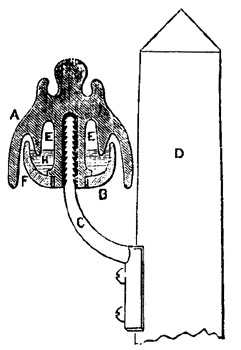 |
| Fig. 1. |
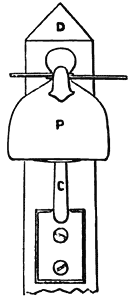 |
| Fig. 2. |
"Fig. 1 represents a section of the insulating support, A is the cap or upper part; B, a half-sphere fitting into the groove, F, of the part A; E, E, the chamber of air; C, an iron support which sustains the insulating system on the pole, and is sealed in the middle. Fig. 2 shows the support mounted on the pole. To show the effects of the exclusion of the air and those of the air chamber, we have coloured red the imprisoned mass of air which represents the part which for constantly dry for the insulation of the line.
"Working.—When the outer air driven by a storm tends to penetrate into the inner chamber, E, E, it compresses the air contained in this chamber, but cannot mix with it, as the inner air cannot be put in vibration, the column of outer air not being able to overcome the obstacle opposed to it by the arrangement of the two portions, A and B. It must enter at F to descend into the chamber E.
"Water cannot enter, for driven by the wind it dashes against the portion B, and can only flow round the edges of the cup and fall back down the pole. We can also put in the air chamber an insulating liquid which would form a liquid excluder.
"It will be seen by the above that what we wish to patent is the arrangement of one of more pieces of insulating material arranged so that they form one or several air chambers into which the outer air and water cannot penetrate, because in order to penetrate it would have to ascend at F, and then descend into the chamber E, which it can only do by compressing the air of the inner chamber, and the density of the outer column of air can never vary sufficiently to overcome this obstacle."
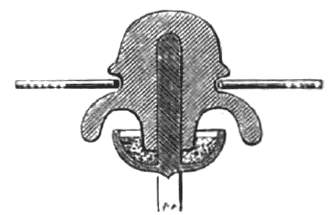 |
| Fig. 3. |
A little while after the above patent was taken out, Messrs. Simond and Gould obtained a French patent dated July 25th, 1869, No. 86,582, for an insulator for telegraph wires, the construction of which may be seen in the drawing (fig. 3).
It is not stated in this last patent, although it is to be found in W. E. Simond's earlier American patent dated June 27, 1869, No. 92,111, that the insulating material placed in the cup forming the lower portion of the insulator was supposed to remain constantly in a liquid state as indicated in Lenoir and Prud'homme's patent.
In fact, it is simply stated that the cup is filled with any non-conducting substance, paraffin, for instance. The work "liquid" is never used in the description, and, of course, the melted paraffin introduced into the cup becomes solid. But, on the contrary, in Lenoir and Prud'homme's patent, we find expressly mentioned "a liquid forming a liquid excluder (fermeture)."
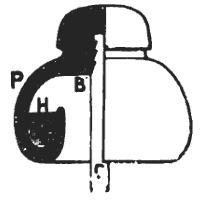 |
| Fig. 4. |
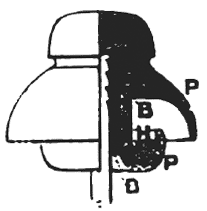 |
| Fig. 5. |
The oil insulators of Messrs. Johnson & Phillips are well known in commerce; it may, however, be worth while to reproduce the drawings accompanying their French patent of November 7th, 1876, No. 115,363 (figs. 4 and 5). This patent states that "the cup is filled with any insulating fluid whatever, preferably a hydro-carburet, which will not bear on its surface either moisture or dust.
From the above examinations of inventions of French, American and English patents, made in the interests of truth and justice, it follows that French inventors were the first to propose the employment of insulating liquids in supports constructed specially for electric wires.
(1) L'Industrie Eleetrique.
(2) See L'Industrie Eledrique for February 26th, 1892, p. 83.
